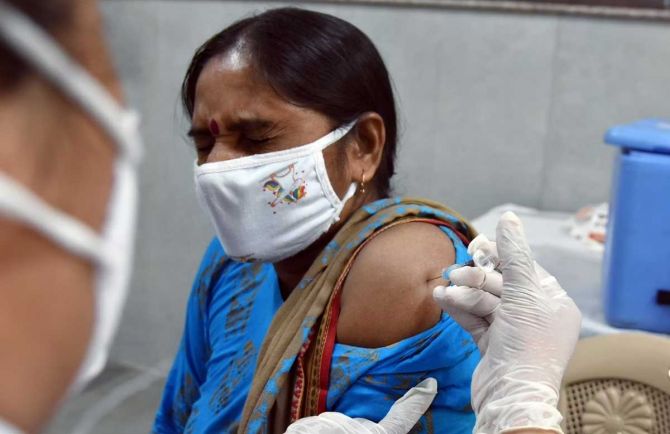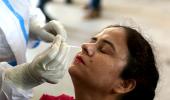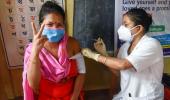'Just put a patch on your arm and the vaccine can be absorbed by the body.'

Having delivered billions of doses of COVID-19 vaccines to the world, Pune's Serum Institute of India is now working on the next leg of growth.
Besides building a pandemic facility of 2 billion annual doses, the privately held firm has begun work on the new-age vaccine delivery systems.
Delivery of vaccines using newer technologies such as skin patches and high speed jets are likely to gain traction in the coming years.
Administering vaccines through the oral and nasal route are also likely to gain popularity over the traditional needle route for the ease of use, and less discomfort to the recipient.
"I have always dreamt of having alternative delivery systems to deliver our vaccines effectively. We have an oral vaccine for children for rotavirus -- this helps to do away with needles and injections," says Adar Poonawalla, CEO, Serum Institute, and son of India's vaccine pioneer Cyrus Poonawalla.
"For instance, we have a flu vaccine which is a nasal vaccine," adds Adar Poonawalla.
Patch technologies for vaccine delivery is one core new area.
"Just put a patch on your arm and the vaccine can be absorbed by the body. This technology is in early stages of clinical development because one has to show comparability that this technology works and gives the same immune response," he explains.
Serum Institute is also working on technology with a high-powered jet that delivers the vaccine into the body.
"Not all vaccines can be used that way if you have gels and other components in the vaccine. It is an evolving process to work with various new technologies," says Poonawalla.
At Serum Institute's 50-acre Manjri, Pune, campus, which houses several vaccine-making facilities, the company has already installed machines and equipment to make prefilled vaccine syringes, fully automated lines that would formulate a vaccine and also lyophilise it (freeze drying).
"Pre-filled syringes to deliver vaccines is just an alternative to administer a vaccine -- it is ready -- to-use and thus easier for a doctor or nurse. This product, however, would cost more. It would be a niche product for high-income markets, including some products for the Indian market as well," says Poonawalla.
Work on vaccine skin patches and high-speed jets has begun globally.
In January, Swiss researchers said they have begun an early stage study to test a next generation COVID-19 vaccine that could be delivered through an arm patch.
Scientists at Stanford University and University of North Carolina (Chapel Hill) are working on a 3D-printed vaccine patch which has microneedles lined up on a polymer patch. These needles are just long enough to reach the skin to deliver the vaccine.
Research has shown that the immune response from the patch was 10 times more than vaccine delivered into the muscle via an injection.
Similarly, Massachusetts-based Vaxxas has a patch delivery technology, HD-MAP, that uses an array of projections to get vaccines to the immune cells below the surface of the skin.
Vaxxas has an exclusive licence to a Sars-CoV-2 spike protein from University of Texas, Austin and is now working on a needle-free, room temperature-stable COVID-19 vaccine patch into the clinical trials. It uses dry-coating technology that could bypass the need to store vaccines in cold-chain conditions.
Such vaccines will be easier to administer, and thus eliminate the need to have skilled vaccinators. Once evolved, some of these could also be self-administered.
India's access to such latest technology may come through the Serum Institute.
Poonawalla says almost 90 per cent of the company's profits are ploughed back to create capacities and also gain access to technologies.
Experts such as Dr Jacob John, senior virologist and former head of the departments of clinical virology and microbiology at the Christian Medical College, Vellore, say vaccine patches can be effective, but the developer has to be cautious that a sufficient dose of antigen is delivered into the body.
"Ayurveda has always believed that our skin not only secretes sweat and sebum, but also absorbs. Vaccine patches work on this premise," says Dr John.
"There are layers of immune or security cells immediately below the epidermal layer of the skin (in the intra-dermal layer). These cells detect any antigens once they enter through the skin and carry them to the nearest lymph nodes to trigger an immune reaction," Dr John explains.
For vaccines which need to be delivered in the intra-dermal layer (such as the rabies vaccine), Dr John feels the skin patches can be a very good alternative.
"If the vaccinator is not skilled enough and the needle prick crosses the intra-dermal layer and reaches the muscles, then the effectiveness of such vaccines are lost," Dr John says.
Also, he points out, syringes create plastic biomedical waste, so any technology that can reduce such waste is a welcome step.
Dr John, however, cautions that skin patches may not work well for adjuvanted vaccines (those that use chemical adjuvants in the formulations).
The jet injector system has already been used during COVID-19.
According to the US Centres for Disease Control and Prevention, a jet injector is a medical device used for vaccination that uses a high-pressure, narrow stream of fluid to penetrate the skin instead of a needle.
Flu vaccines using this technology are already approved.
India's Zydus Lifesciences developed a DNA-plasmid COVID-19 vaccine that uses a PharmaJet needle-free system Tropis applicator.
Bharat Biotech's intranasal COVID-19 vaccine has already completed clinical trials and is likely to be approved in a month or two.
Soon, India's repertoire of vaccines would include these new delivery systems moving forward from the needle and injection mode.
Feature Presentation: Ashish Narsale/Rediff.com











 © 2025
© 2025